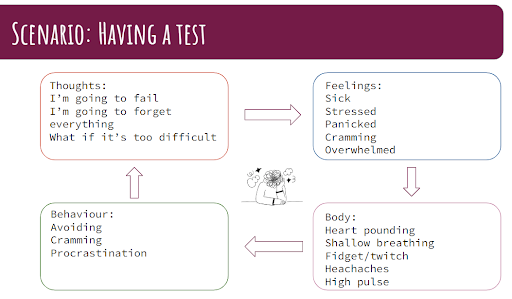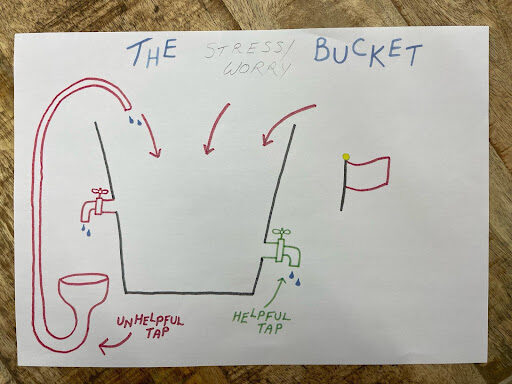Helen Wilson is the Wellbeing Lead at Kings Academy Easthampstead Park School, responsible for creating and delivering wellbeing workshops, 1:1 sessions and policy development.
Although there can be common themes in students, including generalised anxiety, depression, concerns for the future and friendship fallouts, there is no one-size-fits-all for supporting young people’s wellbeing. That’s why providing a safe space to share is crucial for young people to explore their needs and find the best solutions for them.
Here, Helen shares some of the methods she uses to support young people in opening up about their experiences and developing coping strategies to help.
Five activities that encourage young people to open up
The hot cross bun model
‘Hot Cross Bun’ is a popular exercise used in Cognitive Behavioural Therapy. This model helps us understand how our thoughts, emotions, physical state and behaviour can influence one another.
To do this activity:

- Think of a scenario
The scenario could be something coming up or something that has happened, for example, taking a test, going to the dentist, or not being invited to an event.
- Go through your thoughts
For example: “It will be too hard”, “I’m not prepared”, or “They don’t like me”,
- Go through your feeling
For example feeling anxious, scared or sad
- Think about your bodily sensations
What can you feel? i.e. Heart racing, lightheaded, or numb
- Think about your behaviour
How do you respond? Perhaps you avoid revision for your test, cancel your dental appointment or hide away in your room
The more aware we are of our thought processes and how we react to stress and pressure, the easier it is to do something about it.
Tackling Negative Thoughts
I often do the ‘Trigger, Thought, Rationalise’ model to tackle negative thinking patterns with my students. I know how difficult it is in the moment not to let negative thoughts spiral out of control, but writing our thoughts down and trying to counter them can help us gain perspective on the situation.
Trigger, Thought, Rationalise can be done at the time or on reflection to help you gain more perspective.
| Trigger
Think about a time when you felt anxious or low. What prompted this feeling? |
Thought
What negative thoughts did you have at this moment? |
Rationalise
Try to counter your thoughts and think, how would you respond to a friend with these thoughts? |
| Example: Feeling like a failure after getting a U on a mock paper | Example: “I’m a failure” |
Example: “I am not a failure. I had one bad grade. Now I know how to improve.” |
Worry/ Stress buckets
By recognising our worries and stresses, rather than avoiding them, we can find ways to cope with them.

To make a worry bucket:
1. Draw a bucket like the one above
2. Draw a red flag – What are your warning signs? How would someone know you are struggling?
Examples: biting my nails, difficulty sleeping, feeling irritable
3. Going into the bucket, write down everything stressful or worrying to you
Example: worrying about money, applying to Uni, friendship falls out
4. Now draw two taps – one for helpful coping strategies and another for unhelpful coping strategies – Think of how you could relieve this stress or worry.
Helpful tap – talking to friends, having a bath, going for a run
Unhelpful tap – staying in bed, avoiding friends, endless phone scrolling
Practicing gratitude
Looking for the positives every day can be an excellent way to boost your mood and recognise that there has been some good, even on a bad day. Gratitude journaling is popular to set aside a notebook and take a moment before bed to write the positives from the day.
If you need a starting point, here are a few prompts:
One good thing that happened to me today…
Someone I was thankful for today…
Today I smiled when…
Something funny happened today…
My favourite part of today…
Positive Affirmations
Try to back up positive affirmations with reason and evidence to prove them to yourself.
- Pick three positive traits and write them on a piece of paper.
Examples: resilient, caring, hard-working, reliable, honest, loyal, mature, patient, thoughtful, trustworthy, and motivated.
- On the back of the paper, think of a time you demonstrated this trait as a reminder to yourself.
Remember, you can’t pour from an empty glass, so always ensure you are taking time for yourself, practising self-care, and putting in boundaries when necessary.
Interested to find out how a Wellbeing Lead can implement strategies like this in your school? Get in touch




